Four living creatures (Cztery Żywe Stworzenia)
autor Goran Pavlovic © © tłumaczenie Czesław Białczyński

The author of the Book of Ezekiel presents himself as Ezekiel, the son of Buzzi, born into a priestly (Kohen) lineage. Apart from identifying himself, the author gives a date for the first divine encounter which he presents: „in the thirtieth year”. If this is a reference to Ezekiel’s age at the time, he was born around 622 BCE, about the time of Josiah’s reforms. His „thirtieth year” is given as five years after the exile of Judah’s king Jehoiachin by the Babylonians, which according to Josephus happened in 598 BCE.
Autor Księgi Ezechiela przedstawia się jako Ezechiel, syn Buzzi, urodzony w rodzie kapłańskim (Kohen). Autor, poza przedstawieniem się, podaje datę pierwszego przedstawionego przez siebie spotkania Bożego: „w trzydziestym roku”. Jeśli jest to odniesienie do ówczesnego wieku Ezechiela, to urodził się on około 622 roku p.n.e., mniej więcej w czasie reform Jozjasza. Jego „trzydziesty rok” to pięć lat po wygnaniu króla judzkiego Jehojachina przez Babilończyków, co według Józefa Flawiusza miało miejsce w 598 roku p.n.e..
The vision Ezekiel had „in his thirtieth year” and which turned him into a prophet was of Jahveh sitting on the throne carried by the „four living creatures”.
Wizja, którą Ezechiel miał „w trzydziestym roku życia” i która zmieniła go w proroka, dotyczyła Jahwe siedzącego na tronie niesionym przez „cztery żywe stworzenia”.
As I looked, a stormy wind came out of the north: a great cloud with brightness around it and fire flashing forth continually, and in the middle of the fire, something like gleaming amber. In the middle of it was something like four living creatures. This was their appearance: they were of human form. Each had four faces, and each of them had four wings…As for the appearance of their faces: the four had the face of a human being, the face of a lion on the right side, the face of an ox on the left side, and the face of an eagle; such were their faces…
Kiedy patrzyłem, z północy wiał burzowy wiatr: wielka chmura z jasnością wokół niej i nieustannie migocącym ogniem, a w środku ognia coś jak lśniący bursztyn. W środku znajdowało się coś w rodzaju czterech żywych stworzeń. Taki był ich wygląd: miały ludzką postać. Postać ta była czterogłowa i miała cztery skrzydła … Jeśli chodzi o wygląd ich twarzy: czterogłów miał twarz człowieka, twarz lwa po prawej stronie, twarz wołu po stronie lewego boku i twarz orła; takie były ich twarze …
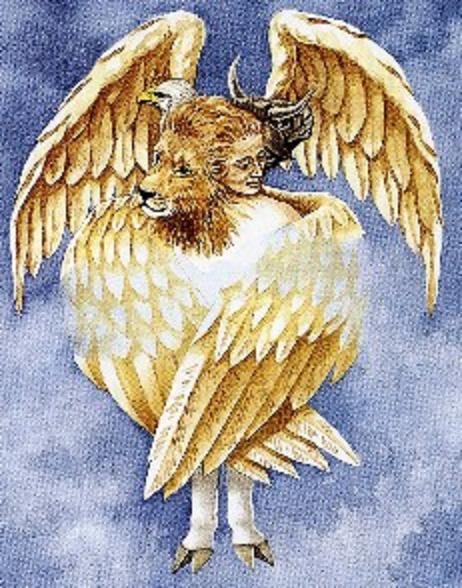
In the middle of the living creatures there was something that looked like burning coals of fire, like torches moving to and fro among the living creatures; the fire was bright, and lightning issued from the fire. The living creatures darted to and fro, like a flash of lightning…As I looked at the living creatures, I saw a wheel on the earth beside the living creatures, one for each of the four of them…When the living creatures moved, the wheels moved beside them; and when the living creatures rose from the earth, the wheels rose. Wherever the spirit would go, they went, and the wheels rose along with them; for the spirit of the living creatures was in the wheels. When they moved, the others moved; when they stopped, the others stopped; and when they rose from the earth, the wheels rose along with them; for the spirit of the living creatures was in the wheels.
Pośrodku żywych stworzeń znajdowało się coś, co wyglądało jak płonące węgle, jak pochodnie poruszające się tam i z powrotem między żywymi stworzeniami; ogień był jasny, a z ognia wydobywała się błyskawica. Żywe stworzenia rzucały się tam i z powrotem, jak błyskawica … Kiedy patrzyłem na żywe stworzenia, widziałem koło na ziemi obok żywych stworzeń, po jednym dla każdego z czterech … Kiedy żywe stworzenia poruszały się, koła poruszały się obok nich; a kiedy istoty żyjące powstały z ziemi, podniosły się koła. Gdziekolwiek duch chciał iść, one szły, a wraz z nimi unosiły się koła; albowiem duch istot żywych był w kołach. Kiedy się ruszali, inni się ruszali; kiedy się zatrzymywali, inni się zatrzymywali; a gdy podnieśli się z ziemi, podniosły się wraz z nimi koła; albowiem duch istot żywych był w kołach.
In another part of his book, Ezekiel identifies the „living creatures” as cherubim, one of the unearthly beings who directly attend to God according to Abrahamic religions. The numerous depictions of cherubim assign to them many different roles; their original duty having been the protection of the Garden of Eden, and in particular the Tree of Life.
W innej części swojej księgi Ezechiel identyfikuje „żywe stworzenia” jako cherubiny, jedną z nieziemskich istot, które zgodnie z religią Abrahama bezpośrednio opiekują się Bogiem. Liczne przedstawienia cherubinów przypisują im wiele różnych ról; ich pierwotnym obowiązkiem była ochrona Ogrodu Edenu, a w szczególności Drzewa Życia.
Interestingly the same vision appeared to the Christian prophet John, who described it in his Revelation:
Co ciekawe, ta sama wizja ukazała się chrześcijańskiemu prorokowi Janowi, który opisał ją w swoim Objawieniu:
In the center, around the throne, were four living creatures, and they were covered with eyes, in front and in back. The first living creature was like a lion, the second was like an ox, the third had a face like a man, the fourth was like a flying eagle. Each of the four living creatures had six wings and was covered with eyes all around, even under its wings.
Pośrodku, wokół tronu, znajdowały się cztery żywe stworzenia i były one schowane przed wzrokiem z przodu i z tyłu. Pierwsza żywa istota była podobna do lwa, druga była jak wół, trzecia miała twarz jak człowiek, a czwarta była jak lecący orzeł. Każde z czterech żywych stworzeń miało sześć skrzydeł i było ukryte przed wzrokiem otoczone dookoła i pod skrzydłami.

Day and night they never stop saying:
„Holy, holy, holy
is the Lord God Almighty
who was, and is, and is to come.”
Dniem i nocą nigdy nie przestają mówić:
„Święty, święty, święty
jest Pan Bóg Wszechmogący
który był, jest i będzie. „
The four living creatures from Ezekiel’s and John’s visions gave birth to the Christian „tetramorph„.
Cztery żywe istoty z wizji Ezechiela i Jana dały początek chrześcijańskiemu „tetramorfowi”.
In Christian art, the tetramorph is the union of the symbols of the Four Evangelists, derived from the four living creatures in the Book of Ezekiel, into a single figure or, more commonly, a group of four figures.
W sztuce chrześcijańskiej tetramorf jest połączeniem symboli czterech ewangelistów, wywodzących się z czterech żywych istot z Księgi Ezechiela, w jedną figurę lub, częściej, grupę czterech postaci.
In their earliest appearances, the Evangelists were depicted in their human forms each with a scroll or a book to represent the Gospels. By the 5th century, images of the Evangelists evolved into their respective tetramorphs, each of the four Evangelists is associated with one of the living creatures, usually shown with wings. The most common association, but not the original or only, is: Matthew the man, Mark the lion, Luke the ox, and John the eagle. Christ in Majesty is often shown surrounded by the four symbols.
W swoich najwcześniejszych przedstawieniach ewangeliści byli pokazywani w swoich ludzkich postaciach, każdy ze zwojem lub księgą przedstawiającą Ewangelie. Do V wieku obrazy ewangelistów ewoluowały w swoje odpowiednie tetramorfy, każdy z czterech ewangelistów jest powiązany z jednym z żywych stworzeń, zwykle przedstawianym ze skrzydłami. Najczęstszym skojarzeniem, ale nie oryginalnym lub jedynym, jest: Mateusz-człowiek, Marek lew, Łukasz wół i Jan orzeł. Chrystus w Majestacie jest często przedstawiany w otoczeniu tych czterech symboli.
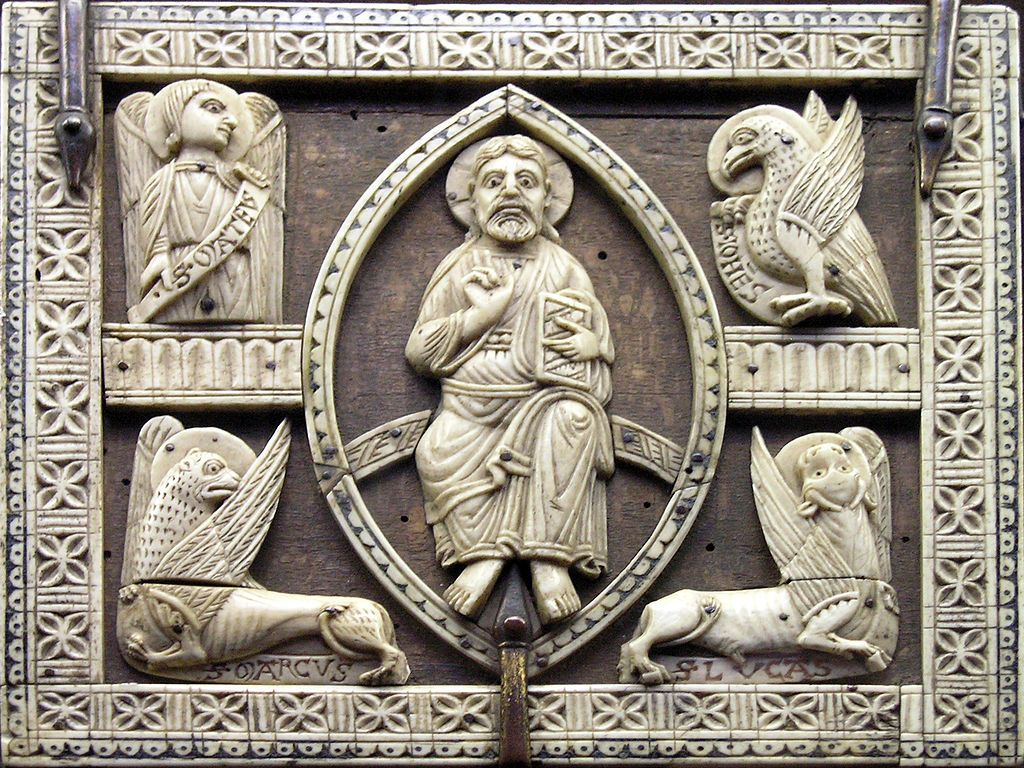
By the later Middle Ages, the tetramorph in the form of creatures was used less frequently. Instead, the Evangelists were often shown in their human forms accompanied by their symbolic creatures, or as men with the heads of animals.
W późniejszym średniowieczu tetramorf w postaci stworzeń był używany rzadziej. Zamiast tego ewangeliści byli często przedstawiani w ludzkich postaciach w towarzystwie ich symbolicznych stworzeń lub jako ludzie z głowami zwierząt.
In images where the creatures surround Christ, the winged man and the eagle are often depicted at Christ’s sides, with the lion and the ox positioned lower by his feet, with the man on Christ’s right, taking precedence over the eagle, and the lion to the left of the ox. These positions reflect the medieval great chain of being.
Na obrazach, na których stworzenia otaczają Chrystusa, skrzydlaty mężczyzna i orzeł są często przedstawiani po bokach Chrystusa, z lwem i wołem umieszczonymi niżej u jego stóp, z człowiekiem po prawej stronie Chrystusa, mającym pierwszeństwo przed orłem i lwem, który jest po lewej stronie wołu. Te pozycje odzwierciedlają średniowieczny wielki łańcuch bytów.
Now how are we to understand these strange creatures from Ezekiel’s and John’s visions? Well this has been bothering people for a long time.
Jak więc mamy rozumieć te dziwne stworzenia z wizji Ezechiela i Jana? Cóż, to tak zaprzątało uwagę ludzi od dawna.
In Judaism the four faces of the living creatures represent different creatures god created. The lion represents all wild animals, the ox represents domestic animals, the human represents humanity, and the eagle represents birds.
Some however have connected Ezekiel’s and John’s visions with strange zodiacs found in synagogues built in holy land during the first few centuries after Christ’s birth. Like this one from Beth Alpha, Israel:
Niektórzy jednak łączą wizje Ezechiela i Jana z dziwnymi zodiakami, które można znaleźć w synagogach zbudowanych na Ziemi Świętej w ciągu pierwszych kilku stuleci po narodzinach Chrystusa. Tak jak ta z Beth Alpha w Izraelu:
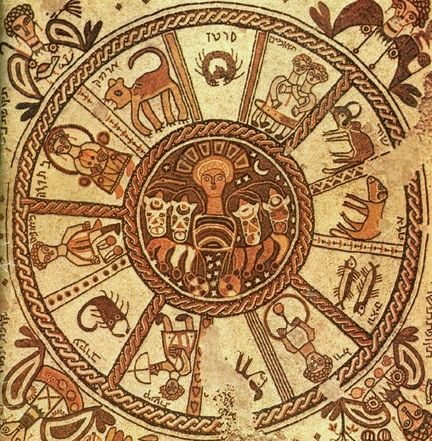
The same type of zodiac wheel, with Helios or Sun in it’s center, sitting in a chariot (throne) pulled by four horses (beings), just like in Ezekiel’s and John’s visions, is found in contemporaneous synagogues throughout Israel such as Naaran, Susiya, Hamat Tiberias, Huseifa, and Sepphoris.
Ten sam typ koła zodiaku, z Heliosem lub Słońcem w jego środku, siedzącym w rydwanie (tronie) ciągniętym przez cztery konie (istoty), podobnie jak w wizjach Ezechiela i Jana, można znaleźć we współczesnych synagogach w całym Izraelu, takich jak Naaran, Susiya , Hamat Tiberias, Huseifa i Sepphoris.
Now when we look at the four faces of the „living creatures” and compare them with the zodiac symbols, we can see that these four faces match the four fixed points of the zodiac:
Teraz, gdy spojrzymy na cztery twarze „żywych stworzeń” i porównamy je z symbolami zodiaku, zobaczymy, że te cztery twarze pasują do czterech stałych punktów zodiaku:
The man is Aquarius
The ox or cherub is Taurus,
The lion is Leo
The eagle is Scorpio (Few people know that Scorpio has another form, Eagle, sometimes Phoenix).
Ten człowiek to Wodnik
Wół lub cherubin to Byk,
Lew to Lew
Orzeł to Skorpion (niewiele osób wie, że Skorpion ma inną postać, Orzeł, czasem Feniks).
When we connect these four points we get a cross:
Kiedy połączymy te cztery punkty, otrzymamy krzyż:
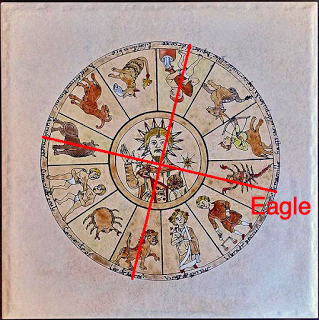
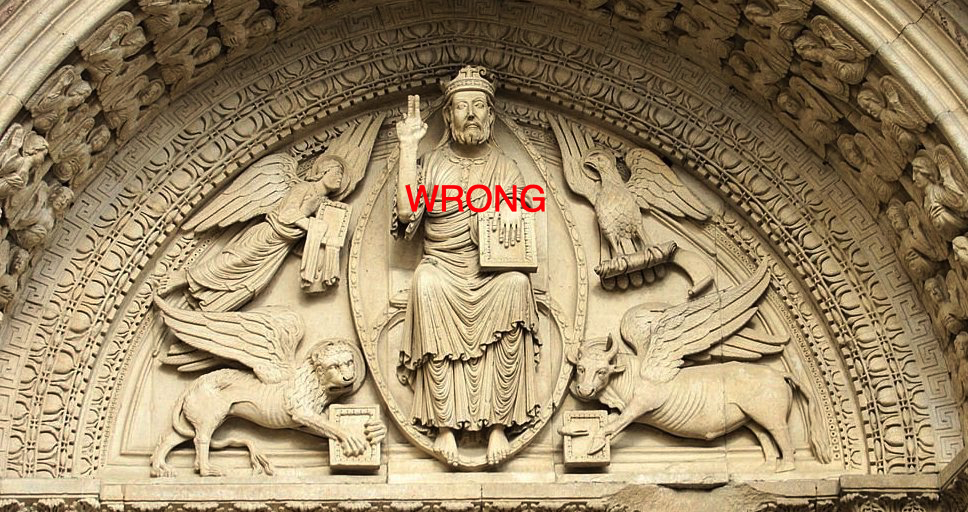
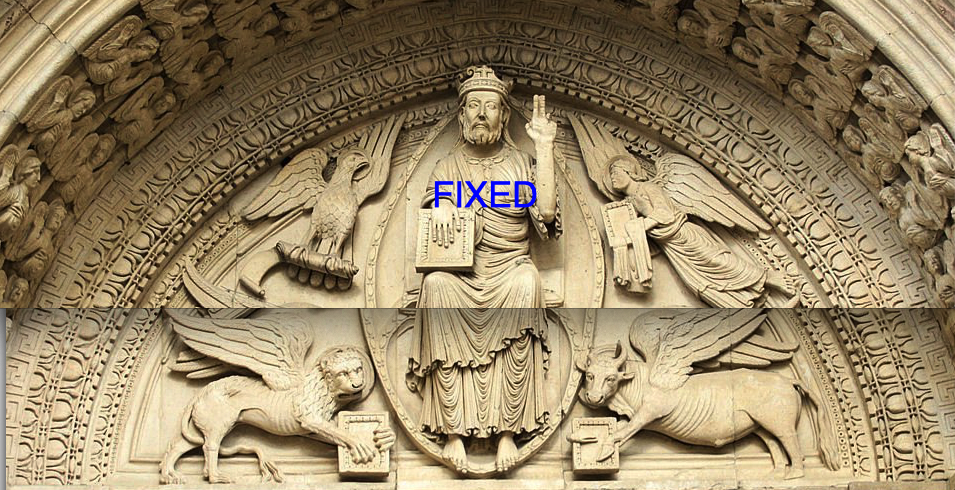
But why did Jews adorn their synagogues during early Christian Era with these strange zodiacs? And what is the reason that these exact four zodiac signs were chosen to be the faces of the „four living creatures”?
Dlaczego Żydzi ozdabiali swoje synagogi we wczesnej erze chrześcijańskiej tymi dziwnymi zodiakami? I jaki jest powód, dla którego te dokładnie cztery znaki zodiaku zostały wybrane jako twarze „czterech żywych stworzeń”?
In my post „Boaz and Jachin” I talked about the significance of the fact that Solomon built his temple on a threshing floor. The reason why this is significant is because in the past threshing floors were not only used for threshing and winnowing, but were also used as solar observatories and for ceremonies which were part of a solar cult. At the end of that article I suggested that the First Temple, whose entrance was oriented towards true east, towards the area of the horizon where the sun rises, was a temple dedicated to the sun and built by sun worshipers. And I said that we actually have indications that this could in fact have been the case.
W moim poście „Boaz i Jachin” mówiłem o znaczeniu tego, że Salomon zbudował swoją świątynię na klepisku. Powodem, dla którego jest to istotne, jest to, że w przeszłości klepiska były używane nie tylko do młócenia i przesiewania, ale były również używane jako obserwatoria słoneczne i do ceremonii, które były częścią kultu słonecznego. Na końcu tego artykułu zasugerowałem, że Pierwsza Świątynia, której wejście było skierowane na prawdziwy wschód, w stronę horyzontu, gdzie wschodzi słońce, była świątynią poświęconą słońcu i zbudowaną przez czcicieli słońca. Powiedziałem, że faktycznie mamy przesłanki, że tak naprawdę mogło być.
In my post Sun god from the first temple I continued talking about this. Interestingly it was Ezekiel who told us explicitly that the First Temple was solar temple.
In Ezekiel 8:16 we read this:
U Ezechiela 8: 16 czytamy, że:
„In the sixth year, in the sixth month on the fifth day, while I was sitting in my house and the elders of Judah were sitting before me, the hand of the Sovereign Lord came on me there. I looked, and I saw a figure like that of a man. From what appeared to be his waist down he was like fire, and from there up his appearance was as bright as glowing metal. He stretched out what looked like a hand and took me by the hair of my head. The Spirit lifted me up between earth and heaven and in visions of God he took me to Jerusalem…He then brought me into the inner court of the house of the Lord, and there at the entrance to the temple, between the portico and the altar, were about twenty-five men. With their backs toward the temple of the Lord and their faces toward the east, they were bowing down to the sun in the east.”
The fact that people still prayed to the sun during the time of Ezekiel is very interesting, because it shows how strong this solar cult was among the people of Judah. Ezekiel was born during the reign of Josiah (649–609 BCE). And it was Josiah, who according to the Hebrew Bible, instituted major religious changes aimed at eradicating the solar cult which flourished in Judah before and during his time. How strong the solar cult was in Judah just before the time of Josiah can be seen from the royal seal of the Kingdom of Judah from the time of the King Hezekiah (739 – 687 BC).
Fakt, że w czasach Ezechiela ludzie nadal modlili się do słońca, jest bardzo interesujący, ponieważ pokazuje, jak silny był ten kult słoneczny wśród ludu Judy. Ezechiel urodził się za panowania Jozjasza (649–609 pne). I to właśnie Jozjasz, zgodnie z Biblią hebrajską, wprowadził poważne zmiany religijne mające na celu wykorzenienie kultu słonecznego, który kwitł w Judzie przed jego czasami. Jak silny był kult słoneczny w Judei tuż przed Jozjaszem, można zobaczyć z królewskiej pieczęci Królestwa Judy z czasów króla Ezechiasza (739 – 687 pne).

This means that the solar cult was not a minor religious curiosity. It was a state religion whose main temple was the First temple. A state religion supported by at least a significant part of the Judah’s population.
Oznacza to, że kult słońca nie był drobną ciekawostką religijną. Była to religia państwowa, której główną świątynią była pierwsza świątynia. Religia państwowa utrzymywana przez co najmniej znaczną część ludności Judei.
So when Josiah started his religious reforms, not everyone was pleased. A lot of people saw these changes as sacrilege and continued to practice the old solar religion.
As part of his crusade, Josiah did the major cleanup of the First temmple. In 2 Kings 23:11 we read:
Kiedy więc Jozjasz rozpoczął reformy religijne, nie wszyscy byli zadowoleni. Wiele osób postrzegało te zmiany jako świętokradztwo i nadal praktykowało starą religię słoneczną.
W ramach swojej krucjaty Jozjasz dokonał gruntownego sprzątania Pierwszej Świątyni. W 2 Królów 23:11 czytamy:
„He (Josiah) removed from the entrance of the LORD’s Temple the horse statues that the former kings of Judah had dedicated to the sun… He also burned the chariots dedicated to the sun…”
„On (Jozjasz) usunął z wejścia do Świątyni Pana posągi koni, które dawni królowie Judei poświęcili słońcu … Spalił także rydwany poświęcone słońcu …”
This is most peculiar. We have a temple, build on a threshing floor (ancient solar observatory). The temple was oriented towards the east, and in the temple people prayed to the rising sun as if it was a god. And the temple housed a chariot and horses dedicated to the sun god???
To jest najbardziej osobliwe. Mamy świątynię zbudowaną na klepisku (starożytne obserwatorium słoneczne). Świątynia była skierowana na wschód, a w świątyni modlono się do wschodzącego słońca, jakby to był bóg. I w świątyni znajdował się rydwan i konie poświęcone bogu słońca ???
Who was this sun god to whom ancient kings of Judah dedicated horses and chariot?
Well Helios of course.
Kim był ten bóg słońca, któremu starożytni królowie Judy poświęcali konie i rydwany? Cóż, oczywiście Helios.

Official story is that Ezekiel really hated the solar worshipers…But now I am wondering…Is it possible that he was actually one of them? Is it possible that he saw Josiah’s reforms as totally sacrilegious and that when he prophesied the destruction of of Jerusalem and the first temple, he did so because he believed that that was the fitting punishment for the Jews turning their backs to the Sun, their God? And is it because of this that he was hated by the same Jews? And is it because of that that his vision of god is basically Sun god sitting in a chariot pulled by four horses???
Oficjalna historia jest taka, że Ezechiel naprawdę nienawidził czcicieli słońca … Ale teraz się zastanawiam … Czy to możliwe, że był jednym z nich? Czy to możliwe, że widział reformy Jozjasza jako całkowicie świętokradcze i że kiedy prorokował zniszczenie Jerozolimy i pierwszej świątyni, zrobił to, ponieważ wierzył, że była to odpowiednia kara dla Żydów odwracających się plecami do Słońca, ich Boga? ? I czy to z tego powodu był nienawidzony przez tych samych Żydów? I czy to dlatego, że jego wizja boga to w zasadzie bóg słońca siedzący w rydwanie ciągniętym przez cztery konie ???
Qumran scrolls, which are attributed to the Essens, seem to confirm that Josephus was telling the truth. In the Hodayom, there are several references to prayer at dawn. 1QH 4:5 states: „I thank thee, O Lord, for Thou hast illuminated my face by Thy covenant, and I seek Thee, and sure as the dawn Thou hast appeared to me as perfect light.”
Zwoje Qumran, które przypisuje się Esseńczykom, zdają się potwierdzać, że Józef Flawiusz mówił prawdę. W Hodayom jest kilka wzmianek o modlitwie o świcie. 1QH 4: 5 mówi: „Dziękuję Ci, Panie, za to, że oświetliłeś moje oblicze swoim przymierzem i szukam Ciebie, i na pewno ukazałeś mi się jako doskonałe światło o świcie”.
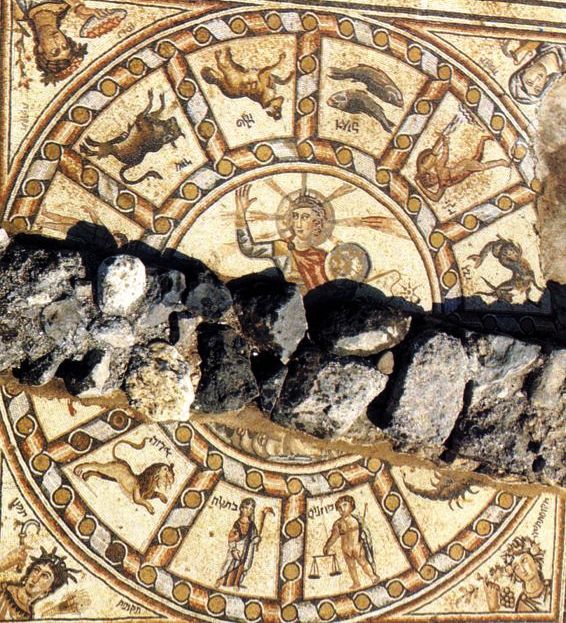
And, at the same time when the helios synagogues were being built, the vision of a god in a chariot appeared to John who described it in Revelation:
I w tym samym czasie, gdy budowano synagogi Heliosa, Janowi ukazała się wizja boga w rydwanie, który opisał to w Objawieniu:
In the centre, around the throne (chariot with four wheels), were four living creatures, and they were covered with eyes, in front and in back. The first living creature was like a lion, the second was like an ox, the third had a face like a man, the fourth was like a flying eagle. Each of the four living creatures had six wings and was covered with eyes all around, even under its wings.
Very interesting right? But the best part is yet to come.
Bardzo interesujące, prawda? Ale najlepsze dopiero przed nami.
Why Man, Bull, Lion and Eagle? Why are these four zodiac signs chosen to be the faces of the living creatures?
Dlaczego człowiek, byk, lew i orzeł? Dlaczego te cztery znaki zodiaku zostały wybrane na twarze żywych stworzeń?
These four zodiac signs cover these four periods of the solar year:
Aquarius 21 January – 19 February
Taurus 21 April – 21 May
Leo 23 July – 22 August
Eagle (Scorpio) 24 October – 22 November
Te cztery znaki zodiaku obejmują te cztery okresy roku słonecznego:
Wodnik 21 stycznia – 19 lutego
Byk 21 kwietnia – 21 maja
Lew 23 lipca – 22 sierpnia
Orzeł (Skorpion) 24 października – 22 listopada
In my post „Two crosses” I talked about Earth’s cross, whose hands point to the so called „cross quarter days” which mark the transitional points of the climatic, vegetative cycle in the northern hemisphere, more precisely Europe:
W swoim poście „Dwa krzyże” mówiłem o krzyżu Ziemi, którego ramiona wskazują na tzw. „Ćwierćdni krzyżowe”, które wyznaczają punkty przejściowe klimatycznego cyklu wegetacyjnego na półkuli północnej, a dokładniej w Europie:
The four points of this solar cross are at the core of the Celtic calendar:
1. Imbolc- the beginning of the spring
2. Bealtaine – the beginning of the summer
3. Lughnasa – the beginning of the autumn
4. Samhain – the beginning of the winter
Cztery punkty tego słonecznego krzyża znajdują się w centrum kalendarza celtyckiego:
1. Imbolc – początek wiosny
2. Bealtaine – początek lata
3. Lughnasa – początek jesieni
4. Samhain – początek zimy
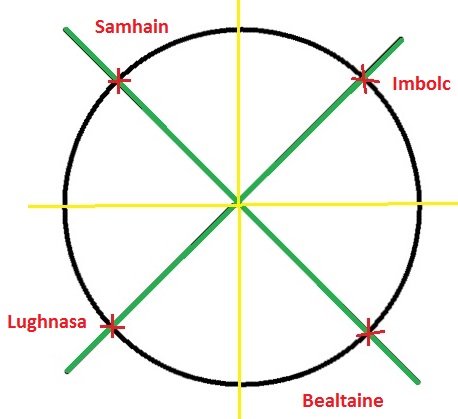
And the Serbian calendar:
1. St Sava – the beginning of the spring
2. St George – the beginning of the summer
3. St Ilija – the beginning of the autumn
4. St Mitar – the beginning of the winter
I kalendarz serbski:
1. Św. Sawa – początek wiosny
2. St George – początek lata
3. St Ilija – początek jesieni
4. St Mitar – początek zimy
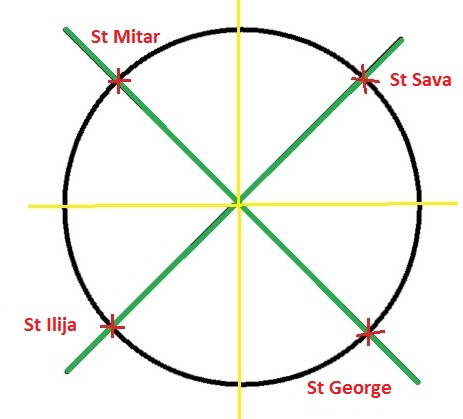
The sun cross (Solstices and Equinoxes) and earth cross (Cross quarter days) are out of sync. The earth cross is rotated forward by 45 degrees and the earth circle cardinal points fall right in between the sun circle cardinal points. This is because the earth climatic, vegetative cycle lags behind the solar cycle.
Krzyż słońca (przesilenia i równonoce) i krzyż ziemi (dni kwartału krzyżowego) nie są zsynchronizowane. Krzyż ziemi jest obrócony do przodu o 45 stopni, a punkty kardynalne okręgu ziemi znajdują się dokładnie pomiędzy głównymi punktami kręgu słonecznego. Dzieje się tak, ponieważ klimatyczny cykl wegetatywny Ziemi pozostaje w tyle za cyklem słonecznym.
Winter solstice (21st of December) is the the shortest day. So we would expect that this is also the coldest day. We would also expect that from that day on, as the days start getting longer, the days also start getting warmer. But as we all know, this is not the case. The days do get longer, but the earth continues to cool. It is only at the beginning of February that we start seeing the first signs of the earth warming up. This is why the beginning of spring is at the beginning of February (Imbolc, St Sava (27th of January, but probably a replacement for the old Imbolc which is celebrated on the 1st of February)). The actual mid point is 4th of February. Which falls right in the middle of Aquarius (21 January – 19 February).
Spring equinox (21st of March) is the moment when the day is as long as night. From that day the days are longer than nights. We would expect that this would mark the beginning of the summer. But the real heat does not start until the beginning of May. This is why the beginning of summer is at the beginning of May (Bealtaine, which is today celebrated on the 1st of May, but there are indications that it was once celebrated on the 6th of May just like St George’s day). The actual mid point is 6th of May. Which falls right in the middle of Taurus (21 April – 21 May).
Równonoc wiosenna (21 marca) to moment, w którym dzień jest tak długi jak noc. Od tego dnia dni są dłuższe niż noce. Spodziewalibyśmy się, że oznaczałoby to początek lata. Ale prawdziwy upał zaczyna się dopiero na początku maja. Dlatego początek lata przypada na początek maja (Bealtaine, które dziś obchodzone jest 1 maja, ale istnieją przesłanki, że kiedyś obchodzono je 6 maja, podobnie jak dzień św. Jerzego). Właściwy punkt środkowy to 6 maja. Która wypada dokładnie w środku Byka (21 kwietnia – 21 maja).
Summer solstice (21st of June) is the longest day of the year. We would expect that this would also be the hottest day of the year. We would also expect that from that day on, as the days get shorter, the days also get colder. But again as we all know, that is not the case. The days do get shorter, but earth continues to warm. It is only at the beginning of August that we start seeing first sings of earth cooling down. This is why the beginning of autumn is at the beginning of August (Lughnasa which is today celebrated on the 1st of August but was once probably celebrated on the, 2nd of August, just like , St Ilija’s day). The actual mid point is 2nd of August. Which falls right in the middle of Leo (23 July – 22 August).
Przesilenie letnie (21 czerwca) to najdłuższy dzień w roku. Spodziewalibyśmy się, że będzie to również najgorętszy dzień w roku. Spodziewalibyśmy się również, że od tego dnia, gdy dni stają się krótsze, stają się również coraz zimniejsze. Ale znowu, jak wszyscy wiemy, tak nie jest. Dni stają się coraz krótsze, ale ziemia nadal się nagrzewa. Dopiero na początku sierpnia zaczynamy widzieć pierwsze oznaki stygnięcia ziemi. Dlatego początek jesieni przypada na początek sierpnia (Lughnasa, która jest dziś obchodzona 1 sierpnia, ale kiedyś prawdopodobnie obchodzona była 2 sierpnia, podobnie jak święto św. Iliji). Właściwy punkt środkowy to 2 sierpnia. Który przypada w sam środek Lwa (23 lipca – 22 sierpnia).
Autumn equinox (21st of September) is the moment when the day is as long as night. From that day the days are shorter than nights. We would expect that this would mark the beginning of the winter. But the real cold does not start until the beginning of Novermber. This is why the beginning of winter is at the beginning of November (Samhain, St Mitar (8th of November, but probably the replacement for the old Samhain which is celebrated on the 31st of October)). The actual mid point is 5th of November. Which falls right in the middle of Eagle (Scorpio) (24 October – 22 November).
Równonoc jesienna (21 września) to moment, w którym dzień jest tak długi jak noc. Od tego dnia dni są krótsze niż noce. Spodziewalibyśmy się, że oznaczałoby to początek zimy. Ale prawdziwy chłód zaczyna się dopiero na początku listopada. Dlatego początek zimy przypada na początek listopada (Samhain, St Mitar (8 listopada, ale prawdopodobnie zastąpienie starego Samhain obchodzone 31 października)). Właściwy punkt środkowy to 5 listopada. Który przypada w sam środek Eagle (Scorpio) (24 października – 22 listopada).
This is indeed incredible. The four points of the vegetative cross define climate, which is created during the continuous interplay between the Father Sun and Mother Earth. I talked about this in my post Yin and Yang. Interestingly these four points fall into four zodiac signs which are the four faces of the four living creatures described by Ezekiel. The four living creatures whom he identifies as cherubim, the guardians of the „Garden of Eden” and particularly „The Tree of Life”. Garden of Eden is this earth and the Tree of Life is the life it produces. The life which can be only produced because the Father Sun and Mother Earth produce the ever changing climate whose change is marked by the four points of the Climatic cross Aquarius = Spring, Taurus = Summer, Leo = Autumn, Eagle = Winter…
To jest naprawdę niesamowite. Cztery punkty krzyża wegetacyjnego określają klimat, który powstaje podczas ciągłej interakcji między Słońcem Ojcem a Matką Ziemią. Mówiłem o tym w moim poście Yin i Yang. Co ciekawe, te cztery punkty należą do czterech znaków zodiaku, które są czterema twarzami czterech żywych stworzeń opisanych przez Ezechiela. Cztery żyjące istoty, które utożsamia z cherubami, strażnikami „Ogrodu Edenu”, a zwłaszcza „Drzewa Życia”. Ogród Eden to ta ziemia, a Drzewo Życia to życie, które wytwarza. Życie, które może powstać tylko dzięki temu, że Ojciec Słońce i Matka Ziemia wytwarzają stale zmieniający się klimat, którego zmiana jest zaznaczona czterema punktami krzyża klimatycznego Wodnik = Wiosna, Byk = Lato, Lew = Jesień, Orzeł = Zima …
The problem with his vision is that this climatic cross only corresponds with the climate in Europe. Not with the climate in Middle East and definitely not with the climate in Babylon…
Problem z jego wizją polega na tym, że ten krzyż klimatyczny koresponduje tylko z klimatem w Europie. Nie z klimatem na Bliskim Wschodzie i na pewno nie z klimatem w Babilonie …
I already said that this climatic cross is at the base of the Serbian and Celtic calendar. Ezekiel (allegedly) had his vision in the 6th century BC. Solomon who built the solar temple on David’s threshing floor (allegedly) built it in the 10th century BC.
Powiedziałem już, że ten krzyż klimatyczny jest podstawą kalendarza serbskiego i celtyckiego. Ezechiel (rzekomo) miał swoją wizję w VI wieku pne. Salomon, który zbudował słoneczną świątynię na klepisku Dawida (rzekomo), zbudował ją w X wieku pne.
There is no mention of anything like it in Hebrew Scriptures or Tradition. So why would Ezekiel „see” it in his vision?
Nie ma wzmianki o czymś podobnym ani w Pismach Hebrajskich, ani w Tradycji. Dlaczego więc Ezechiel „widział” to w swojej wizji?
The thing is this climatic cross was already known and was already sacred during the early Bronze Age. In Ireland. The same place where we found the so called „Celtic calendar” based on the above four cross quarter days. How do we know this? Well because we have stone circles aligned with these cross quarter days.
This is Grange stone circle. It is located on Lough Gur in County Limerick, Ireland. Composed of 113 standing stones, the Grange Stone Circle is the largest and finest in Ireland. Seán P. Ó Ríordáin excavated the Grange Stone Circle in 1939. During the excavations he found more than 4,000 shards of pottery, dating from the Early Neolithic to the Late Bronze Age, spanning a period of some 2,600 years.
To jest kamienny krąg Grange. Znajduje się na Lough Gur w hrabstwie Limerick w Irlandii. Złożony ze 113 stojących kamieni, kamienny krąg Grange jest największym i najwspanialszym w Irlandii. Seán P. Ó Ríordáin odkopał kamienny krąg folwarkowy w 1939 roku. Podczas wykopalisk znalazł ponad 4000 odłamków ceramiki, datowanych od wczesnego neolitu do późnej epoki brązu, obejmujących okres około 2600 lat.
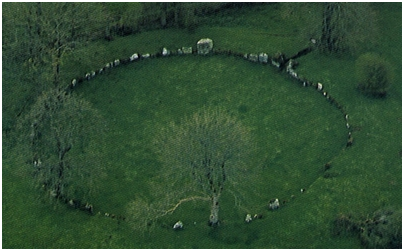

This is the ceremonial entrance. It is lined with stones in the same way as the Grange circle itself. The very entrance of the circle is marked with two large stones.
To jest uroczyste wejście. Jest wyłożone kamieniami w taki sam sposób, jak sam krąg Grange. Samo wejście do kręgu jest oznaczone dwoma dużymi kamieniami.
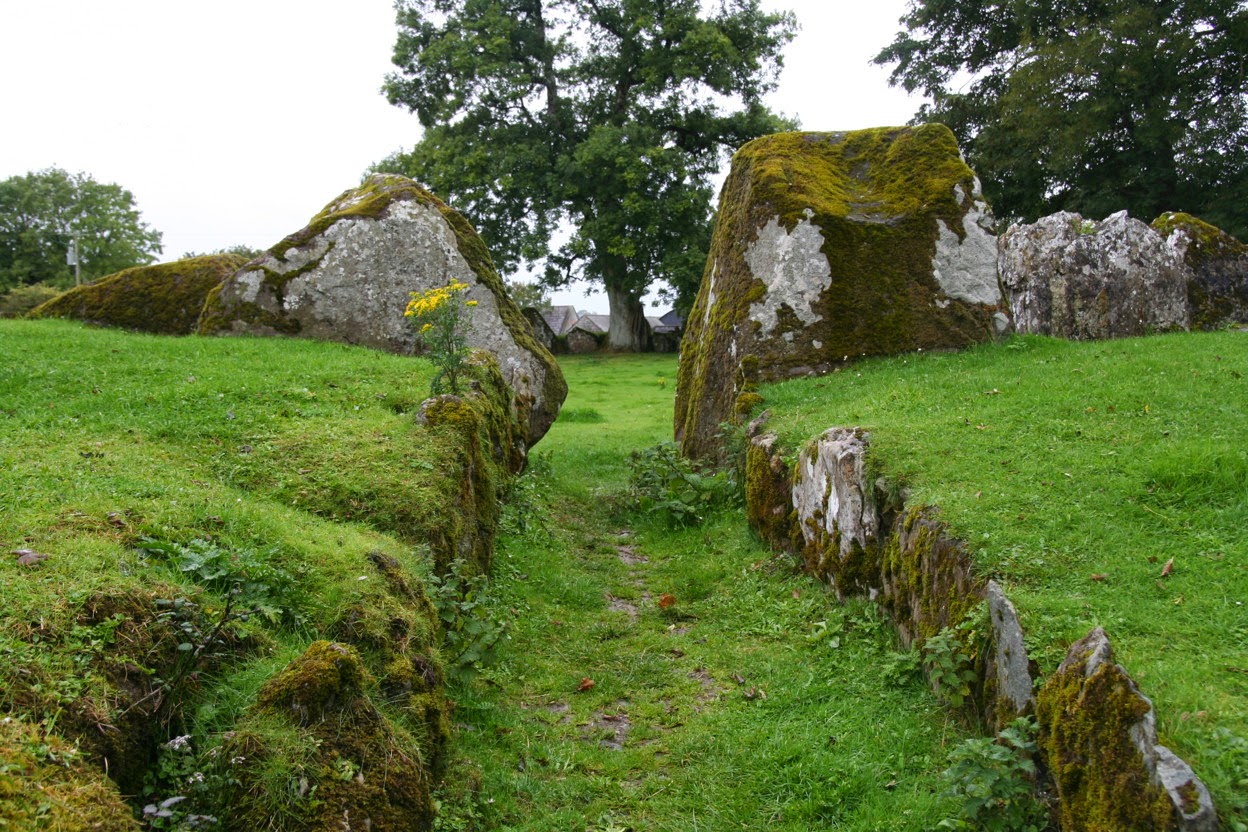
This ceremonial entrance is aligned with the sunrise on the first or second of August, the Day of Crom Dubh, Lughnassa, the day of Perun, Thundering sun Ilios.
To uroczyste wejście pokrywa się ze wschodem słońca pierwszego lub drugiego sierpnia, w dzień Crom Dubh, Lughnassa, dzień Peruna, grzmiącego słońca Ilios.
This is Beltany stone circle. It is located at Beltany, Co. Donegal. The name Beltany is an anglicised version of the Irish Beltaine, Beltane. The stone circle dates from around 1400-800 BC. Some reports are even saying that the actual building date is 2000 BC. The complex comprises a stone circle of 64 stones around a low earth platform or tumulus, situated at the summit of Beltany Hill.

The stone circle has several alignments:
1. Alignment with the sunrise on the day of Bealltaine (6th May, middle of Taurus), the Beginning of Summer.
2. Alignment with the sunrise on the day of the Winter Solstice (21st of December).
3. Alignment with the sunrise on the day of Samhain (1st of November, middle of Eagle, Scorpio), the Beginning of Winter.
4. Alignment with the sunrise on the day of the Equinoxes (21st March and 21st September).
Kamienny krąg ma kilka ustawień:
1. Wyrównanie ze wschodem słońca w dniu Bealltaine (6 maja, środek Taurus), początek lata.
2. Wyrównanie ze wschodem słońca w dniu przesilenia zimowego (21 grudnia).
3. Wyrównanie ze wschodem słońca w Samhain (1 listopada, środek Eagle, Scorpio), początek zimy.
4. Dostosowanie do wschodu słońca w dniu równonocy (21 marca i 21 września).
So Bronze Age Irish were already aligning their solar circles with the climatic cross at least a thousand years before Ezekiel had his vision of the „four living creatures pulling the throne of god”. How did these symbols which make no sense in Middle East find their way there? Who brought them, when?
Tak więc Irlandczycy z epoki brązu już ustawiali swoje kręgi słoneczne z krzyżem klimatycznym co najmniej tysiąc lat przed tym, jak Ezechiel miał swoją wizję „czterech żywych stworzeń ciągnących tron boga”. W jaki sposób te symbole, które nie miały sensu na Bliskim Wschodzie, znalazły się tam? Kto je przyniósł, kiedy?
A million dolars question 🙂
Milion dolarów za odpowiedź na to pytanie.
źródło: https://oldeuropeanculture.blogspot.com/2019/04/four-living-creatures.html
